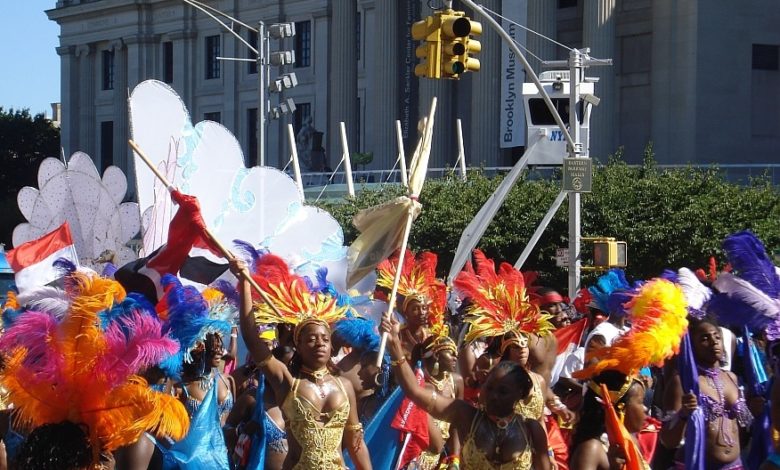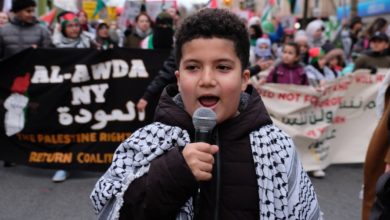
Police showed up en masse to patrol the West Indian Day Parade in Brooklyn, an annual celebration for Black New Yorkers, as rents and evictions skyrocket.
The police presence was formidable all across Eastern Parkway on Sept. 5, as the world-famous West Indian Day Parade was taking place in the Crown Heights neighborhood of Brooklyn, New York City. The street was crowded with blue police barricades and metal gates set up alongside parade attendees, who were mostly Black and donned the flags of various Caribbean nations.
The policy of heavy policing was dreaded by some in the community since it was announced at a press conference on Sept. 2. “We’re not looking to go out there and be heavy handed,” said NYPD Chief of Patrol Jeffrey Maddrey on Friday. For the traditional Caribbean celebration that takes place the morning of the West Indian Day Parade, J’Ouvert, the NYPD announced that, “everyone entering the area … will be subject to screening by handheld metal detectors, from Sunday, Sept. 4, at 11 p.m. through Monday, Sept. 5, at 11 a.m.” Revelers were to be searched for weapons as well as alcohol.
“This parade being one of the few parades that’s dedicated to Black, Indigenous, Brown culture, is the parade that’s the most criminalized by the NYPD,” said anti-police brutality activist and lifelong Crown Heights resident Kerbie Joseph. “People who live in their own communities are being subjugated to checkpoints in their own neighborhoods.”
History of Brooklyn’s West Indian Day Parade
The origins of West Indian Day celebrations have deep ties to slavery and Black resistance. When French colonists barred enslaved people from celebrating in their masquerade balls in Trinidad, slaves put on their own balls, often using the celebrations as a tool to mock their enslavers. Out of this came the celebration of J’ouvert, a word which likely originated from the Antillean Creole French word jou ouvè, which means “dawn.”
J’ouvert celebrations in New York City began with West Indian immigrants like Jesse Waddle, who in the 1920s began to organize the first Caribbean diaspora carnival celebrations in Harlem. Over time, the West Indian Parade moved to its current location in central Brooklyn where it remains today as one of the largest parades in New York City.
Over-policing as part of the process of gentrification
However, today, with Black Brooklyn under constant attack by gentrification, the parade is beginning to look far different.
“What was once a very freeing experience on Labor Day Monday now feels very restricted,” DJ SKA, a Brooklyn-based DJ and Barbadian immigrant told Gothamist.
The white population has doubled in Crown Heights over the last decade, and with that, so-called “quality of life” complaints, such as complaints over noise or loitering, have skyrocketed. In 2017, white Crown Heights resident Kathleen Reilly, was notorious in central Brooklyn for falsifying such complaints against her West Indian neighbors. Despite her harassment against the community, the Brooklyn District Attorney declined to prosecute her.
But racism perpetrated by residents like Reilly is only the tip of the iceberg in the larger problem of gentrification and displacement. Pandemic protections like the New York State eviction moratorium have been lifted now that the worst months of COVID are over, and eviction is accelerating across the city as rents skyrocket. The central Brooklyn neighborhood of Flatbush, home to a vibrant Caribbean diaspora, had the highest number of eviction filings in the last four weeks at 229. Median rents in Brooklyn jumped 17% from 2021 to early 2022, at $2,800 per month.
And over-policing plays a role in gentrification: An analysis of data from New York City from 2009 to 2015, shows that areas with increased real estate investment saw increased misdemeanor policing, and neighborhoods with increasing property values saw more arrests for minor offenses such as drug possession.
Double standards
“I’ve been to many parades in my life, and I can’t recall any other parade where there’s this much police. Not for Gay Pride, not for St. Patty’s. It’s very overwhelming,” said Diego Brown, a West Indian Day Parade attendee from Queens.
Even before the parade, NYPD announced it planned a heavy presence at the celebration.
“This week in particular the message was very clear, not come out here to fight, to engage in any violence, to carry any weapons,” said NYPD chief of patrol Jeffrey Maddrey in the days leading up to the West Indian Day Parade. An article published on the NY1 website read like an unedited police press release: “NYPD bosses say they want people to have fun and cops will not over-police the crowd, but rather help keep the peace so everyone can enjoy the colorful celebration.”
But as Brown explained, “Gun violence is perpetrated by all communities, there’s no proliferation in one community more than the other. And so it makes no sense to discriminate against the Black community.”
In 1997, teenager Michael Sarti was beaten to death at the St. Patrick’s Day parade in Manhattan. In 2015, two teenagers were rushed to Bellevue Hospital after a violent altercation on St. Patrick’s Day. And yet, some were outraged at then-Mayor Bill deBlasio for daring to compare the violence at J’ouvert to the violence at St. Patrick’s Day or the Puerto Rican Parade in 2016. Then-Police Commissioner Willian Bratton said of J’ouvert, “the nature of the violence is different.”
More than once, rank-and-file NYPD officers have gone online to spread racist messaging against the West Indian Day Parade and related celebrations. In 2011, NYPD officers posted in a Facebook group called “No More West Indian Day Detail,” calling participants “animals” and “savages.” One comment read, “Drop a bomb and wipe them all out.” In 2016, through an online message board, NYPD officers placed bets on how much violence would take place on J’ouvert. “Place your bet’s [sic] gentlemen, the mayhem is about to start,” wrote one officer. “So what will be the final numbers for the 2016 celebration of a beautiful culture?”
And residents have taken notice of the increased police presence and harassment.
“I definitely saw more police officers interrogating and investigating a lot of these Black folks in this neighborhood last night. And everyone was just having a party,” said parade attendee Valerie. “I’m not a fan of this.”







